.
31.03.2014
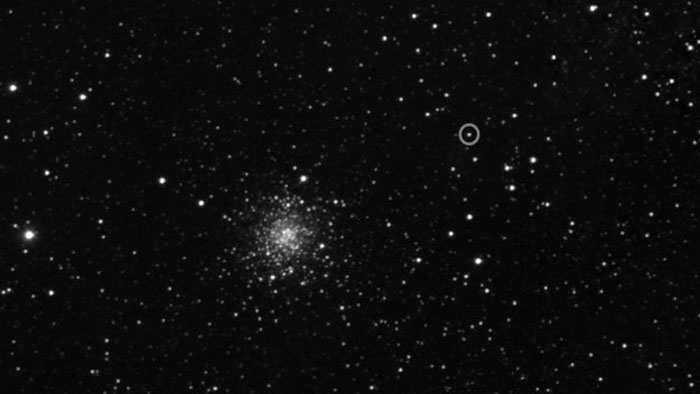
Rosetta’s first sighting of its target in 2014 – narrow angle view
.
ESA’s Rosetta spacecraft has caught a first glimpse of its destination comet since waking up from deep-space hibernation on 20 January.
These two ‘first light’ images were taken on 20 and 21 March by the OSIRIS wide-angle camera and narrow-angle camera, as part of six weeks of activities dedicated to preparing the spacecraft’s science instruments for close-up study of comet 67P/Churyumov–Gerasimenko.
OSIRIS, the Optical, Spectroscopic and Infrared Remote Imaging System, developed under the leadership of the Max-Planck-Institut für Sonnensystemforschung in Göttingen, Germany, has two cameras for imaging the comet. One covers a wide angle, while the narrow-angle camera covers a smaller field at higher resolution.
.
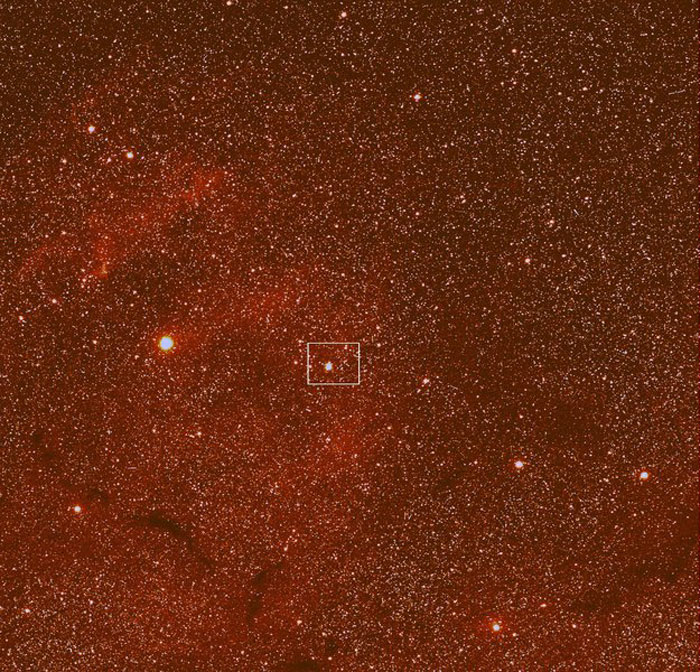
Comet 67P/Churymov-Gerasimenko in the constellation of Ophiuchus. This image was taken with the OSIRIS Wide Angle Camera on 20 March and shows a wide field 25 times larger than the diameter of the full moon. The colour composite shows a background of hydrogen gas and dust clouds in the constellation Ophiuchus. The white box indicates the position of the close-up taken with the Narrow Angle Camera, with the comet appearing towards the top of this box, close to the bright globular star cluster M107. The image was taken from a distance of about 5 million kilometres to the comet.
.
OSIRIS is one of a suite of 11 science instruments on the Rosetta orbiter that together will provide details on the comet’s surface geology, its gravity, mass, shape and internal structure, its gaseous, dust-laden atmosphere and its plasma environment.
Rosetta has been travelling through the Solar System for 10 years, and will finally arrive at the comet in August this year. It first imaged the comet in a long exposure of over 13 hours from a distance of 163 million kilometres, three years ago, before entering deep-space hibernation.
Rosetta is currently around 5 million kilometres from the comet, and at this distance it is still too far away to resolve – its light is seen in less than a pixel and required a series of 60–300 second exposures taken with the wide-angle and narrow-angle camera. The data then travelled 37 minutes through space to reach Earth, with the download taking about an hour per image.
“Finally seeing our target after a 10 year journey through space is an incredible feeling,” says OSIRIS Principal Investigator Holger Sierks from the Max Planck Institute for Solar System Research in Germany. “These first images taken from such a huge distance show us that OSIRIS is ready for the upcoming adventure.”
“This is a great start to our instrument commissioning period and we are looking forward to having all 11 instruments plus lander Philae back online and ready for arriving at the comet in just a few month’s time,” says Matt Taylor, ESA’s Rosetta project scientist.
OSIRIS and the spacecraft’s dedicated navigation cameras will regularly acquire images over the coming weeks to help refine Rosetta’s trajectory in order to bring it steadily in line with the comet ahead of the rendezvous.
Currently, Rosetta is on a trajectory that would, if unchanged, take it past the comet at a distance of approximately 50 000 km and at a relative speed of 800 m/s. A critical series of manoeuvres beginning in May will gradually reduce Rosetta’s velocity relative to the comet to just 1 m/s and bring it to within 100 km by the first week of August.
Between May and August the 4 km-wide comet will gradually ‘grow’ in Rosetta’s field of view from appearing to have a diameter of less than one camera pixel to well over 2000 pixels – equivalent to a resolution of around 2 m per pixel – allowing the first surface features to be resolved.
These early observations will allow the rotation rate and the shape of the nucleus to be better understood, crucial for planning manoeuvres around the comet. An initial assessment of the comet’s activity will also be possible.
With OSIRIS re-activated in the first week of instrument commissioning, Rosetta’s 10 other science experiments, along with lander Philae, will provide the focus for the next months’ activities.
.
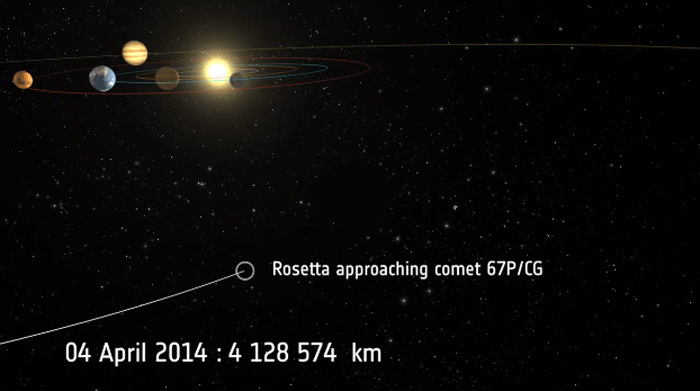
.

.
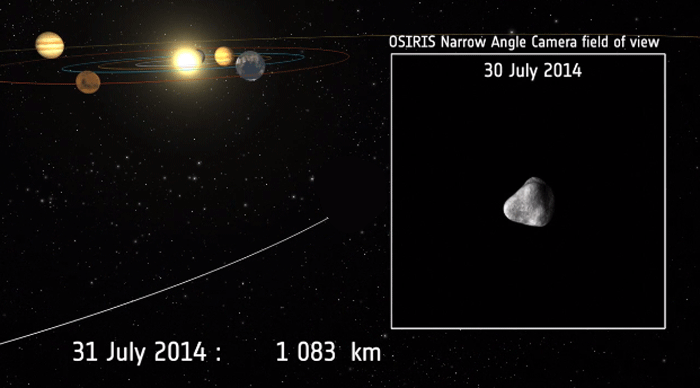
.

Quelle: ESA
.
Update: 15.05.2014
.
ROSETTA´S TARGET COMET IS BECOMING ACTIVE
.
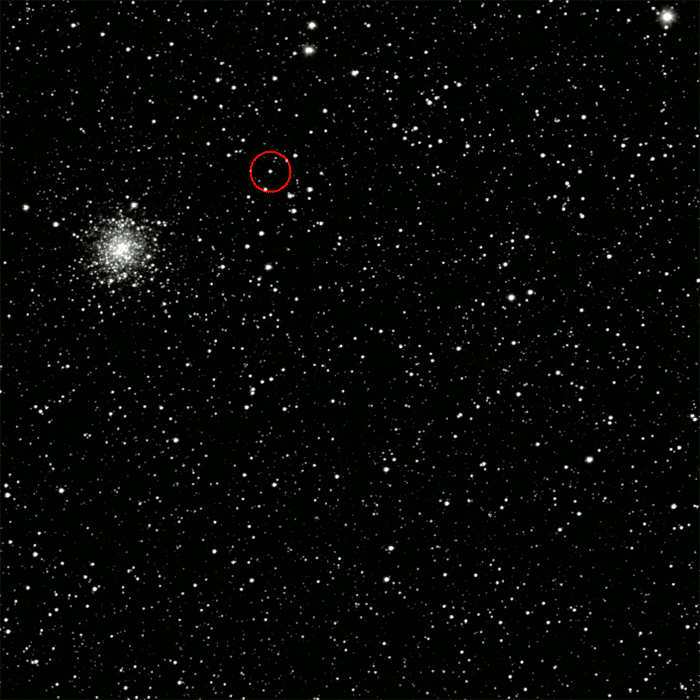
The target of ESA’s Rosetta mission has started to reveal its true personality as a comet, its dusty veil clearly developing over the last six weeks.
The sequence of images presented here of comet 67P/Churyumov–Gerasimenko were taken between 27 March and 4 May, as the gap between craft and comet closed from around 5 million km to 2 million km.
By the end of the sequence, the comet’s dusty veil – the ‘coma’ – extends some 1300 km into space. By comparison, the nucleus is roughly only 4 km across, and cannot yet be ‘resolved’.
The coma has developed as a result of the comet moving progressively closer to the Sun along its 6.5 year orbit. Even though it is still more than 600 million km from the Sun – more than four times the distance between Earth and Sun – its surface has already started to warm, causing its surface ices to sublimate and gas to escape from its rock–ice nucleus.

Comet on 30 April
.
As the gas escapes, it also carries a cloud of tiny dust particles out into space, which slowly expands to create the coma.
As the comet continues to move closer to the Sun, the warming continues and activity rises, and pressure from the solar wind will eventually cause some of the material to stream out into a long tail.
Rosetta and the comet will be closest to the Sun in August 2015, between the orbits of Earth and Mars.
The onset of activity now offers scientists the opportunity to study dust production and structures within the coma before getting much closer.
“It’s beginning to look like a real comet,” says Holger Sierks, principal investigator for OSIRIS, the Optical, Spectroscopic and Infrared Remote Imaging System, at the Max Planck Institute for Solar System Research, Germany.
“It’s hard to believe that only a few months from now, Rosetta will be deep inside this cloud of dust and en route to the origin of the comet’s activity.”
In addition, tracking the periodic changes in brightness reveals the nucleus is rotating every 12.4 hours – about 20 minutes shorter than previously thought.
“These early observations are helping us to develop models of the comet that will be essential to help us navigate around it once we get closer,” says Sylvain Lodiot, ESA Rosetta spacecraft operations manager.
OSIRIS and the spacecraft’s dedicated navigation cameras have been regularly acquiring images to help determine Rosetta’s exact trajectory relative to the comet. Using this information, the spacecraft has already started a series of manoeuvres that will slowly bring it in line with the comet before making its rendezvous in the first week of August.
Detailed scientific observations will then help to find the best location on the comet for the Philae lander’s descent to the surface in November.
Quelle: ESA
.
Update: 16.05.2014
.
It’s Alive! Rosetta’s Comet Flares As It Approaches The Sun
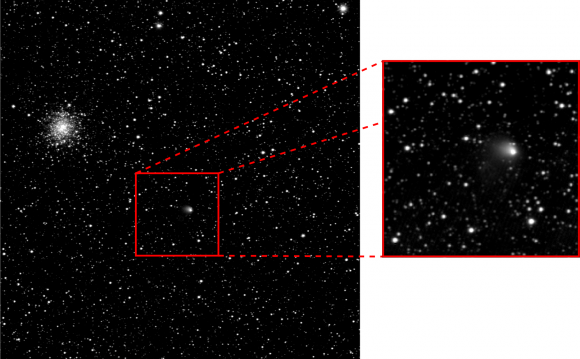
A close-up of comet 67P/Churyumov–Gerasimenko taken from 1.24 million miles (2 million km) away. The image was obtained by the Rosetta spacecraft in April 2014 as it approached the comet for a close-up view. Credit: ESA/Rosetta/MPS for OSIRIS Team MPS/UPD/LAM/IAA/SSO/INTA/UPM/DASP/IDA
.
Wow! This image shows the target comet for the Rosetta mission starting to develop a tail. This bodes well for the European Space Agency spacecraft, which is on its way to study Comet 67P/Churyumov–Gerasimenko later this year to learn more about the origins of the solar system.
“It’s beginning to look like a real comet,” stated Holger Sierks, principal investigator for OSIRIS (Optical, Spectroscopic and Infrared Remote Imaging System.)
“It’s hard to believe that only a few months from now, Rosetta will be deep inside this cloud of dust and en route to the origin of the comet’s activity,” added Sierks, who is with the Max Planck Institute for Solar System Research in Germany.
The picture was one of a series taken over six weeks, between March 27 and May 4, as the spacecraft zoomed to within 1.24 million miles (two million kilometers) of the target. You can see the full animation by clicking on the image below.
The comet is now about four times as far from the Sun as the Earth is. Even from afar, the Sun’s heat is warming the comet’s ice, causing dust and vapor to carry out into space — forming the coma. The coma will develop into a long tail when the comet gets even closer to the sun.
Rosetta will be the comet’s companion as it draws closer to the sun; its closest approach will be in August 2015, when it is between the orbits of Earth and Mars. So far, the spacecraft’s 11 instruments appear to be in excellent health, ESA stated, although the agency is remaining cautious as the rendezvous date approaches. The spacecraft will begin orbital insertion activities later this month, and send out its Philae lander in November.
“We have a challenging three months ahead of us as we navigate closer to the comet, but after a 10-year journey it’s great to be able to say that our spacecraft is ready to conduct unique science at comet 67P/C-G,” stated Fred Jansen, ESA’s Rosetta mission manager.
Quelle: UT
.
Update: 22.05.2014
.
Rosetta comet-chaser completes 'big burn'

Rosetta will fly around the comet, edging ever closer before dropping off its landing probe
.
Europe's comet-chaser Rosetta has taken a big step towards making its historic rendezvous with a 4km-wide ball of ice and rock in early August.
.
Controllers confirm the spacecraft conducted a major orbit manoeuvre on Wednesday without incident.
The near-eight-hour thruster burn was designed to slow the satellite's speed relative to Comet 67P/C-G.
More adjustments are required, but the operation was a significant event in ensuring Rosetta meets its target.
The pair are roughly 500 million km from Earth and separated by about a million km, and closing.
Wednesday's big burn was initiated at 15:23 GMT (16:23 BST; 17:23 CEST). It was intended to take out a big chunk (almost 300m/s) of the velocity Rosetta had (755m/s) with respect to 67P/Churyumov-Gerasimenko.
Engineers at the European Space Agency's (Esa) "mission control" in Darmstadt, Germany, will have to examine in detail the telemetry they received from the satellite but confirmed on Thursday that the manoeuvre was "completed nominally".
"The thrusters and propulsion system overall performed very well, and we had a nominal completion of the burn at 22:39 UTC (00:39 CEST Thursday)," said Rosetta Spacecraft Operations Manager Sylvain Lodiot.
"It will take a few days for the flight dynamics team to analyse data and determine the final actual change in speed, but it won't be too far from what we planned," he told the mission blog.
There had been some concern prior to the burn that a leak in the system used to pressurise the propellant tanks might result in uneven combustion, but Paolo Ferri, who heads up the European Spacecraft Operations Centre (Esoc), described Rosetta as having "very stable performance".
Comet 67P/C-G is travelling around the Sun on a big loop that takes it out beyond the orbit of Jupiter and then back in to just inside the orbit of Mars.
Rosetta is attempting to target its rendezvous at the start of the inward curve, before our star can warm the icy object to trigger large jets of gas and dust from its surface.
The mission goal is to orbit the comet, starting on 6 August, and then follow the body in its orbit.
In November, an attempt will be made to put a small lander, called Philae, on 67P's surface.
If all goes well, the mission should return some remarkable insights on the behaviour and chemical make-up of its icy quarry.
Eight further burns are required to get Rosetta into position. The next two, on 4 June and 18 June, are somewhat smaller than Wednesday's manoeuvre.
.

Quelle: BBC
.
Update: 11.06.2014
.
NASA Instruments Begin Science on European Spacecraft Set to Land on Comet
.
Three NASA science instruments aboard the European Space Agency's (ESA) Rosetta spacecraft, which is set to become the first to orbit a comet and land a probe on its nucleus, are beginning observations and sending science data back to Earth.
Launched in March 2004, Rosetta was reactivated January 2014 after a record 957 days in hibernation. Composed of an orbiter and lander, Rosetta’s objective is to arrive at comet 67P/Churyumov-Gerasimenko in August to study the celestial object up close in unprecedented detail and prepare for landing a probe on the comet's nucleus in November.
Rosetta’s lander will obtain the first images taken from a comet’s surface and will provide the first analysis of a comet's composition by drilling into the surface. Rosetta also will be the first spacecraft to witness at close proximity how a comet changes as it is subjected to the increasing intensity of the sun's radiation. Observations will help scientists learn more about the origin and evolution of our solar system and the role comets may have played in seeding Earth with water, and perhaps even life.
"We are happy to be seeing some real zeroes and ones coming down from our instruments, and cannot wait to figure out what they are telling us," said Claudia Alexander, Rosetta's U.S. project scientist at NASA's Jet Propulsion Laboratory (JPL) in Pasadena, California. "Never before has a spacecraft pulled up and parked next to a comet. That is what Rosetta will do, and we are delighted to play a part in such a historic mission of exploration."
Rosetta currently is approaching the main asteroid belt located between Jupiter and Mars,. The spacecraft is still about 300,000 miles (500,000 kilometers) from the comet, but in August the instruments will begin to map its surface.
The three U.S. instruments aboard the spacecraft are the Microwave Instrument for Rosetta Orbiter (MIRO), an ultraviolet spectrometer called Alice, and the Ion and Electron Sensor (IES). They are part of a suite of 11 science instruments aboard the Rosetta orbiter.
MIRO is designed to provide data on how gas and dust leave the surface of the nucleus to form the coma and tail that gives comets their intrinsic beauty. Studying the surface temperature and evolution of the coma and tail provides information on how the comet evolves as it approaches and leaves the vicinity of the sun.
Alice will analyze gases in the comet's coma, which is the bright envelope of gas around the nucleus of the comet developed as a comet approaches the sun. Alice also will measure the rate at which the comet produces water, carbon monoxide and carbon dioxide. These measurements will provide valuable information about the surface composition of the nucleus.
The instrument also will measure the amount of argon present, an important clue about the temperature of the solar system at the time the comet's nucleus originally formed more than 4.6 billion years ago.
IES is part of a suite of five instruments to analyze the plasma environment of the comet, particularly the coma. The instrument will measure the charged particles in the sun's outer atmosphere, or solar wind, as they interact with the gas flowing out from the comet while Rosetta is drawing nearer to the comet's nucleus.
NASA also provided part of the electronics package for the Double Focusing Mass Spectrometer, which is part of the Swiss-built Rosetta Orbiter Spectrometer for Ion and Neutral Analysis (ROSINA) instrument. ROSINA will be the first instrument in space with sufficient resolution to be able to distinguish between molecular nitrogen and carbon monoxide, two molecules with approximately the same mass. Clear identification of nitrogen will help scientists understand conditions at the time the solar system was formed.
U.S. scientists are partnering on several non-U.S. instruments and are involved in seven of the mission's 21 instrument collaborations. NASA's Deep Space Network (DSN) is supporting ESA's Ground Station Network for spacecraft tracking and navigation.
Rosetta is an ESA mission with contributions from its member states and NASA. Rosetta's Philae lander is provided by a consortium led by the German Aerospace Center, Cologne; Max Planck Institute for Solar System Research, Göttingen; French National Space Agency, Paris; and the Italian Space Agency, Rome. JPL manages the U.S. contribution of the Rosetta mission for NASA's Science Mission Directorate in Washington. JPL also built the MIRO and hosts its principal investigator, Samuel Gulkis. The Southwest Research Institute (San Antonio and Boulder), developed the Rosetta orbiter's IES and Alice instruments, and hosts their principal investigators, James Burch (IES) and Alan Stern (Alice).
Quelle: NASA
.
Update: 12.06.2014
.
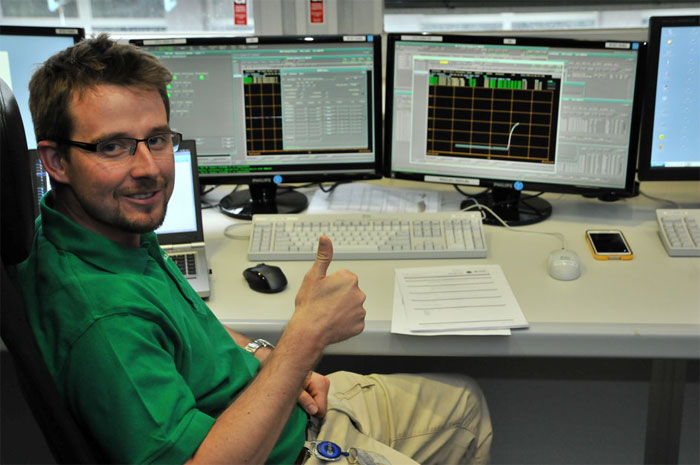
Die Kometensonde Rosetta ist auf dem richtigen Weg: Gestern um 16:21 MESZ erfolgte das zweite große Bremsmanöver, das den Anflug der Sonde auf ihren Zielkometen 67P/Churyumov-Gerasimenko verlangsamte. Wie geplant schlug die Temperaturkurve der Triebwerke am Mittwochabend nach oben aus. Aus der Anzeige am Bildschirm kann Rosetta-Flugingenieur Jakub Urbanek im Satellitenkontrollzentrum der ESA in Darmstadt erkennen, dass die Triebwerke erfolgreich gezündet haben und Rosetta dadurch abgebremst werden konnte.
Die Zündung am Mittwoch war die dritte in einer ganzen Reihe von Kurskorrekturmanövern. Bahn- und Geschwindigkeitsangleichungen der Rosetta-Sonde sind nötig, damit sie am entscheidenden Tag nicht einfach am Kometen vorbeifliegt. Im August wird Rosetta den Kometen erreichen und in eine Umlaufbahn mit ihm einschwenken, im November wird dann das Landegerät Philae auf der Kometenoberfläche aufsetzen.
Seit zehn Jahren ist Rosetta bereits im Weltall unterwegs. Am 2. März 2004 wurde sie mit einer Ariane 5-Rakete vom europäischen Weltraumhafen in Kourou (Französisch-Guayana) aus gestartet. Die Mission soll Antworten auf die Frage geben, ob Kometen Bausteine des Lebens auf die Erde gebracht haben.
Quelle: ESA
.
Update: 20.06.2014
.
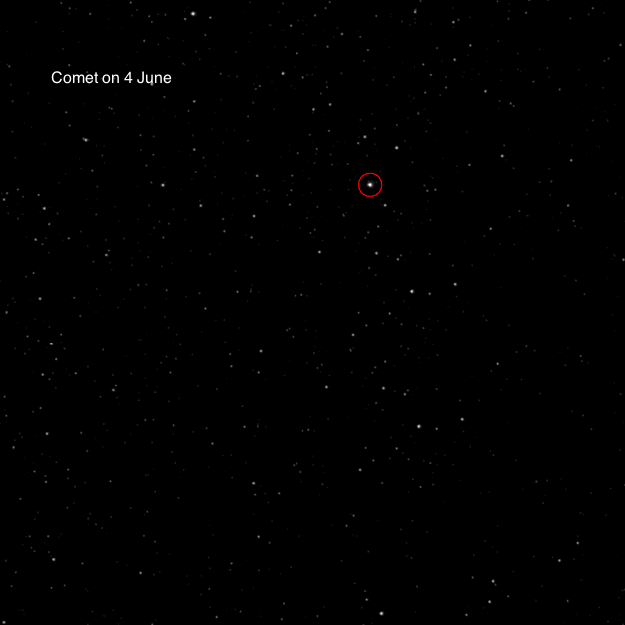
An image snapped earlier this month by ESA’s Rosetta spacecraft shows its target comet has quietened, demonstrating the unpredictable nature of these enigmatic objects.
The picture was captured on 4 June by Rosetta’s scientific camera, and is the most recent full-resolution image from the narrow-angle sensor. It has been used to help fine-tune Rosetta’s navigation towards comet 67P/Churyumov–Gerasimenko, which was 430 000 km away at the time.
Strikingly, there is no longer any sign of the extended dust cloud that was seen developing around nucleus at the end of April and into May, as shown in our last image release. Indeed, monitoring of the comet has shown a significant drop in its brightness since then.
“The comet is now almost within our reach – and teaching us to expect the unexpected,” says the camera’s Principal Investigator Holger Sierks from the Max Planck Institute for Solar System Research in Germany.
“After its onset of activity at the end April, our images are currently showing a comet back at rest.”
While it is not uncommon for comets to display varying levels of activity, it is the first time that scientists have witnessed changes in dust production from such a close distance.
A comet’s ‘coma’ develops as it moves along its orbit progressively closer to the Sun, the increasing warmth causing surface ices to sublimate and gas to escape from its rock–ice nucleus.
As the gas flows away from the nucleus, it also carries a cloud of tiny dust particles out into space, which slowly expands to create the coma.
The warming continues and activity rises as the comet moves ever closer to the Sun. Eventually, pressure from the solar wind causes some of the material to stream out into a long tail.
As comets are non-spherical and lumpy, this process is often unpredictable, with activity waxing and waning as they warm. The observations made over the six weeks from the end of April to early June show just how quickly the conditions at a comet can change.
Since Rosetta’s instruments were reactivated earlier this year after a long hibernation, the scientific and navigation cameras have been regularly acquiring images to help define Rosetta’s trajectory to the comet.
Using this information, the spacecraft has been making a series of manoeuvres that will slowly bring it in line with the comet before their rendezvous in the first week of August.
Four manoeuvres have been completed already – the most recent was yesterday – with six more to go. The last in the sequence is planned for 6 August, when Rosetta will be 100 km from the comet and will embark on a series of complex manoeuvres to bring it closer still.
Quelle: ESA
.
Update: 30.06.2014
.
ROSETTA´S Komet kommt ins schwitzen...
.
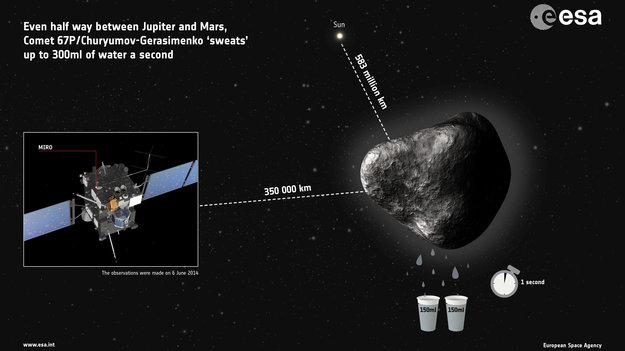
First detection of water vapour
.
ESA’s Rosetta spacecraft has found that comet 67P/Churyumov–Gerasimenko is releasing the equivalent of two small glasses of water into space every second, even at a cold 583 million kilometres from the Sun.
The first observations of water vapour streaming from the comet were made by the Microwave Instrument for Rosetta Orbiter, or MIRO, on 6 June, when the spacecraft was about 350 000 kilometres from the comet.
Since the initial detection, water vapour has been found every time MIRO has been pointed towards the comet.
“We always knew we would see water vapour outgassing from the comet, but we were surprised at how early we detected it,” says Sam Gulkis, the instrument’s principal investigator at NASA’s Jet Propulsion Laboratory in Pasadena, California, USA.
“At this rate, the comet would fill an Olympic-size swimming pool in about 100 days. But, as it gets closer to the Sun, the gas production rate will increase significantly. With Rosetta, we have an amazing vantage point to observe these changes up close and learn more about exactly why they happen.”
Water is a major volatile component of comets, along with carbon monoxide, methanol and ammonia. MIRO is designed to help determine the abundance of each of these ingredients, in order to understand the nature of the comet’s nucleus, the process of outgassing and where they originate on the surface.
These gases stream away from the nucleus carrying dust, forming the comet’s surrounding ‘coma’. As the comet moves closer to the Sun, its coma will expand and, eventually, pressure from the solar wind will cause some of the material to stream out into a long tail.
Rosetta will be there to watch these developments up close. The comet – and Rosetta – will make its nearest approach to the Sun in August 2015, between the orbits of Earth and Mars.
Determining the changes in production rate of water vapour and other gases as the icy object moves around the Sun is important for comet science. But it is also vital for mission planning, because once Rosetta is closer to the comet, the outflow of gases may alter the craft’s trajectory.
“Our comet is coming out of its deep-space slumber and beginning to put on a show for Rosetta’s science instruments,” says Matt Taylor, ESA’s Rosetta project scientist.
“Rosetta’s engineers will also be using MIRO’s observations to help them plan for future mission events when we are operating close to the comet’s nucleus.”
Today, the spacecraft is within 72 000 km of its destination. Six out of a total of ten rendezvous manoeuvres still need to be carried out to ensure that Rosetta arrives at a distance of just 100 km from the nucleus on 6 August.
Quelle: ESA
.
Update: 3.07.2014
.
Der Komet nimmt Form an: ROSETTA sendet neue Aufnahmen ihres Ziels
.
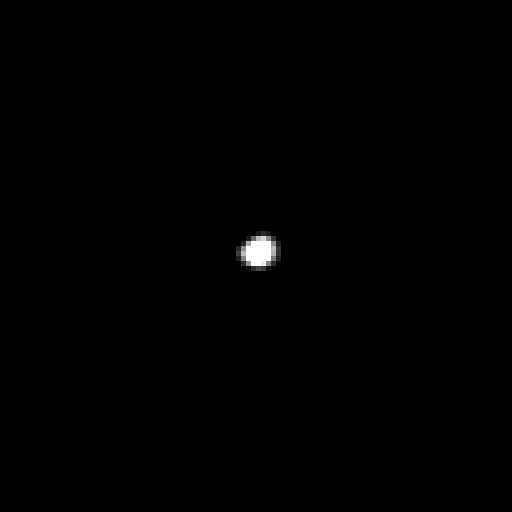
Comet 67P/Churyumov–Gerasimenko, seen in Rosetta's OSIRIS narrow-angle camera on 28 June 2014, from a distance of about 86 000 km. The comet covers about four pixels in this image and appears, as expected, rather fuzzy from this distance.
.
Am 6. August wird die ESA-Sonde Rosetta nach einer zehnjährigen Reise durch unser Sonnensystem ihr Ziel erreichen – den Kometen Churyumov–Gerasimenko. OSIRIS, das Kamerasystem an Bord der Sonde, lieferte jetzt mit seiner NAC-Kamera (Narrow Angle Camera) dieses Bild des Kometen. Die ESA wird von nun an wöchentlich neue Bilder veröffentlichen, die den Kometen von Mal zu Mal größer abbilden und somit neue Hinweise auf dessen Form geben.
Noch befindet sich Rosetta, die vom ESA-Satellitenkontrollzentrum (ESOC) in Darmstadt aus gesteuert wird, im Anflug auf den Kometen. Dieses Foto wurde am 28. Juni aufgenommen, als die Sonde 86 000 Kilometer von ihm entfernt war. Der Komet ist auf dieser Aufnahme rund vier Pixel groß. Die Animation dazu besteht aus 36 Einzelbildern, die am 27. und 28. Juni aufgenommen wurden. Sie zeigt, wie sich der Kometenkern mit einer Rotationszeit von 12,4 Stunden um sich selbst dreht.
.
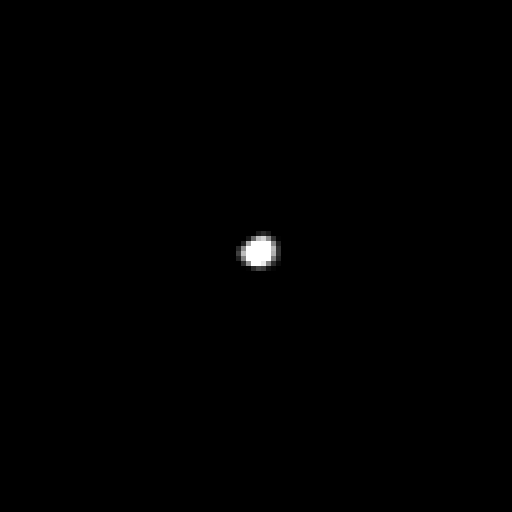
Der rotierende Zielkomet Churyumov–Gerasimenko
.
Wie erwartet erscheint der Komet aus dieser großen Distanz noch etwas unscharf. Dies ist aber nicht etwa auf eine Koma des Kometen zurückzuführen, sondern vielmehr auf die Art und Weise, wie das Licht innerhalb des Kamerasystems gestreut wird. Dieser Effekt wird nicht mehr bemerkbar sein, wenn Rosetta näher an den Kometen vorrücken und die sehnlichst erwarteten hochauflösenden Bilder schicken wird. Das wissenschaftliche Kamerasystem OSIRIS wurde von einem Konsortium unter Leitung des Max-Planck-Instituts für Sonnensystemforschung (MPS) gebaut. Wissenschaftlicher Leiter des OSIRIS-Teams ist Dr. Holger Sierks in Göttingen.
Lange wird es nicht mehr dauern, bis wir mehr vom Kometen zu sehen bekommen: Innerhalb der nächsten zwei Wochen wird Rosetta Aufnahmen liefern, auf denen der Komet bereits einen Bereich von 20 x 20 Pixeln einnehmen wird.
.
Rosetta ist weniger als 50000 Kilometer von ihrem Zielkometen entfernt
Heute, am 3. Juli, ist Rosetta noch rund 43 000 Kilometer von ihrem Zielkometen entfernt. Ende dieser Woche werden es nur noch weniger als 36 000 Kilometer sein. Zum Vergleich: Geostationäre Satelliten umkreisen die Erde in etwa dieser Höhe.
Gesteuert wird die Rosetta-Sonde vom Europäischen Satellitenkontrollzentrum in Darmstadt. Als erster Raumflugkörper soll sie im August in eine Umlaufbahn mit dem Kometen einschwenken, im November das vom Deutschen Zentrum für Luft- und Raumfahrt (DLR) geführte Landegerät Philae auf seiner Oberfläche absetzen und den Kometen anschließend weiter bei seinem Flug um die Sonne begleiten. Die Mission soll zur Beantwortung der Frage beitragen, ob Kometen einst die Bausteine des Lebens auf die Erde gebracht haben.
Quelle: ESA
.
Update: 11.07.2014
.
Rosetta kommt Kometen immer näher
.

Comet on 4 July 2014
Comet 67P/Churyumov-Gerasimenko, taken by the narrow angle camera of Rosetta’s scientific imaging system, OSIRIS, on 4 July 2014, at a distance of 37 000 km. The three images are separated by 4 hours, and are shown in order from left to right. The comet has a rotation period of about 12.4 hours. It covers an area of about 30 pixels, and although individual features are not yet resolved, the image is beginning to reveal the comet’s irregular shape.
Credits: ESA/Rosetta/MPS for OSIRIS Team MPS/UPD/LAM/IAA/SSO/INTA/UPM/DASP/IDA
.
Quelle: ESA
.
Update: 16.07.2014
.
Rosetta-Ziel ist ein "doppelter" Komet
.
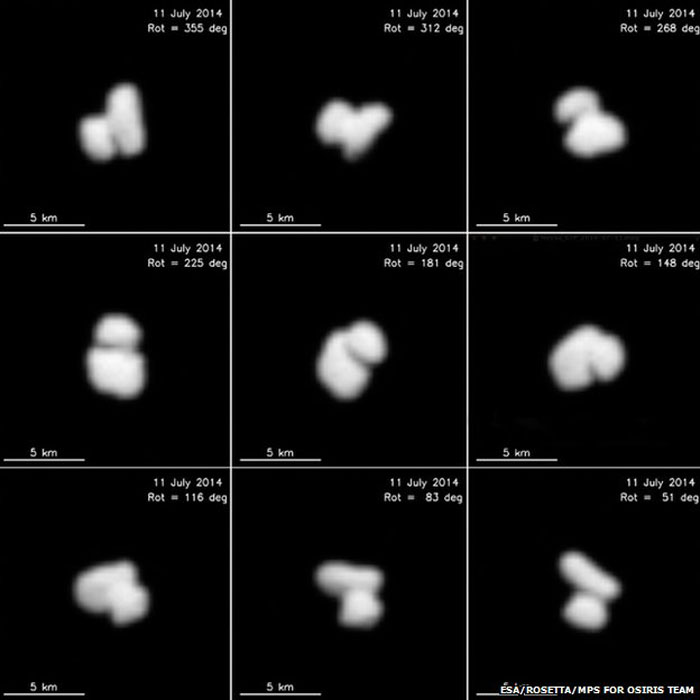
What is the history of Comet 67P? How did it come to take this form?
.
Europe's Rosetta probe has acquired some sensational new images of the comet it is chasing through space.
The pictures show that 67P/Churyumov-Gerasimenko appears to be not one but two objects joined together. It is what scientists call a "contact binary".
How the comet came to take this form is unknown.
It is possible that 67P suffered a major fracture at some point in its past; it is also possible the two parts have totally different origins.
What is clear is that the European Space Agency (Esa) mission team now has additional and unexpected considerations as it plans how to land on the comet later this year - not least, which part of the comet should be chosen for a touchdown?
The images in the sequence of nine were acquired last Friday.
They are an interpolation. That is, the "real" pictures are much more pixelated because of the thousands of km that still separate the probe and the comet. The outlines that you see have therefore been "smoothed" to make the scene easier to understand.
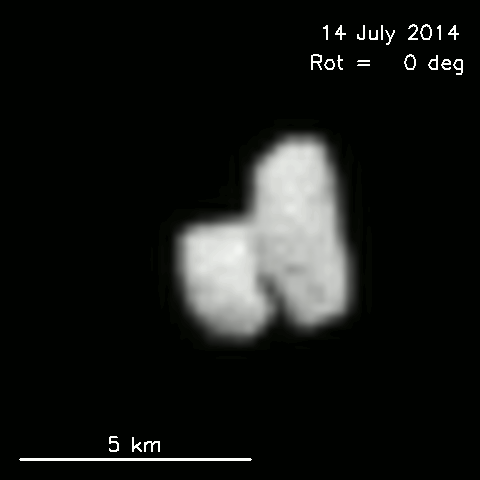
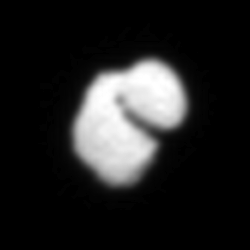
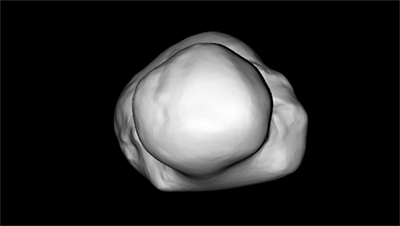
Rosetta's Osiris Narrow Angle Camera has a whole series of images that can be run together as a movie. This is expected to be released later this week.
With hindsight, there were indications in last week's official image release that something unusual might be about to unfold. But the idea that 67P could be a contact binary is a major surprise.
Rosetta is still refining its rendezvous with the comet, firing its thrusters weekly to bring itself into orbit on 6 August.
By that stage, the Esa probe should be no more than 70km from the surface of the 4.5km-wide ball of ice.
Once scientists understand better the gravitational field of 67P, the orbit will be lowered to about 30km.
It is that point that mapping can begin to select a touchdown zone for Philae - the small landing robot currently riding piggyback on Rosetta.
This historic touchdown is currently scheduled for 11 November.
Quelle: BBC
.
Update: 19.07.2014
.

This week’s images of comet 67P/Churyumov-Gerasimenko reveal an extraordinarily irregular shape. We had hints of that in last week’s images and in the unscheduled previews that were seen a few days ago, and in that short time it has become clear that this is no ordinary comet. Like its name, it seems that comet 67P/C-G is in two parts.
What the spacecraft is actually seeing is the pixelated image shown at right, which was taken by Rosetta’s OSIRIS narrow angle camera on 14 July from a distance of 12 000 km.
A second image and a movie show the comet after the image has been processed. The technique used, called “sub-sampling by interpolation”, only acts to remove the pixelisation and make a smoother image, and it is important to note that the comet’s surface features won’t be as smooth as the processing implies. The surface texture has yet to be resolved simply because we are still too far away; any apparent brighter or darker regions may turn out to be false interpretations at this early stage.
But the movie, which uses a sequence of 36 interpolated images each separated by 20 minutes, certainly provides a truly stunning 360-degree preview of the overall complex shape of the comet. Regardless of surface texture, we can certainly see an irregular shaped world shining through. Indeed, some people have already likened the shape to a duck, with a distinct body and head.
Although less obvious in the ‘real’ image, the movie of interpolated images supports the presence of two definite components. One segment seems to be rather elongated, while the other appears more bulbous.
Dual objects like this – known as ‘contact binaries’ in comet and asteroid terminology – are not uncommon.
Indeed, comet 8P/Tuttle is thought to be such a contact binary; radio imaging by the ground-based Arecibo telescope in Puerto Rico in 2008 suggested that it comprises two sphere-like objects. Meanwhile, the bone-shaped comet 103P/Hartley 2, imaged during NASA’s EPOXI flyby in 2011, revealed a comet with two distinct halves separated by a smooth region. In addition, observations of asteroid 25143 Itokawa by JAXA’s Hayabusa mission, combined with ground-based data, suggest an asteroid comprising two sections of highly contrasting densities.
Is Rosetta en-route to rendezvous with a similar breed of comet? The scientific rewards of studying such a comet would be high, as a number of possibilities exist as to how they form.
One popular theory is that such an object could arise when two comets – even two compositionally distinct comets – melded together under a low velocity collision during the Solar System’s formation billions of years ago, when small building blocks of rocky and icy debris coalesced to eventually create planets. Perhaps comet 67P/C-G will provide a unique record of the physical processes of accretion.
Or maybe it is the other way around – that is, a single comet could be tugged into a curious shape by the strong gravitational pull of a large object like Jupiter or the Sun; after all, comets are rubble piles with weak internal strength as directly witnessed in the fragmentation of comet Shoemaker-Levy 9 and the subsequent impacts into Jupiter, 20 years ago this week. Perhaps the two parts of comet 67P/C-G will one day separate completely.
.

Comet 67P/Churyumov-Gerasimenko was imaged on 14 July 2014 by OSIRIS, Rosetta’s scientific imaging system, from a distance of approximately 12 000 km. This image has been processed using ‘sub-sampling by interpolation’, a technique that removes the pixelisation and makes a smoother image. It does not, however, reveal hidden detail and it is therefore important to note that the comet’s surface is not very likely to be as smooth as the processing implies. The image suggests that the comet may consist of two parts: one segment seems to be rather elongated, while the other appears more bulbous.
.
On the other hand, perhaps comet 67P/C-G may have once been a much rounder object that became highly asymmetric thanks to ice evaporation. This could have happened when the comet first entered the Solar System from the Kuiper Belt, or on subsequent orbits around the Sun.
One could also speculate that the striking dichotomy of the comet’s morphology is the result of a near catastrophic impact event that ripped out one side of the comet. Similarly, it is not unreasonable to think that a large outburst event may have weakened one side of the comet so much that it simply gave away, crumbling into space.
But, while the interpolated images are certainly brilliant, we need to be closer still to see a better three-dimensional view – not to mention to perform a spectroscopic analysis to determine the comet’s composition – in order to draw robust scientific conclusions about this exciting comet.
Rosetta Mission Manager Fred Jansen comments: “We currently see images that suggest a rather complex cometary shape, but there is still a lot that we need to learn before jumping to conclusions. Not only in terms of what this means for comet science in general, but also regarding our planning for science observations, and the operational aspects of the mission such as orbiting and landing.
“We will need to perform detailed analyses and modelling of the shape of the comet to determine how best we can fly around such a uniquely shaped body, taking into account flight control and astrodynamics, the science requirements of the mission, and the landing-related elements like landing site analysis and lander-to-orbiter visibility. But, with fewer than 10 000 km to go before the 6 August rendezvous, our open questions will soon be answered.”
Quelle: ESA
.
Update: 24.07.2014
.
Erste Eindrücke der Oberfläche von Rosettas Zielkomet

Modell der Kometenform, basierend auf den Aufnahmen vom 14. Juli 2014.
.
Die neuen Bilder des Kometen 67P/Churyumov-Gerasimenko lassen bereits Strukturen seiner Oberfläche erkennen. Sie wurden mit der OSIRIS-Kamera an Bord von Rosetta aus 5.500 Kilometern Entfernung gemacht, ihre Auflösung beträgt 100 Meter pro Bildpunkt (Pixel) und trotzdem ist darauf zu erkennen, dass die Region an der sich der Komet verengt, deutlich heller ist als die beiden anderen Teile.
.

Der Komet 67P/Churyumov-Gerasimenko, aufgenommen am 20. Juli 2014 von der OSIRIS-Kamera an Bord der Rosetta-Raumsonde.
.
Die zuletzt veröffentlichten Bilder haben gezeigt, dass der Komet aus zwei miteinander verbundenen Teilen besteht: einem kleineren "Kopf" und einem größeren "Körper". Dieses Verbindungsstück, der "Hals", zeigt sich auf den neuen Bildern jetzt schon als besonders interessant für die Wissenschaftler. Denn diese Region ist heller als der Rest des Kometen. Mögliche Gründe hierfür könnten Unterschiede in der Zusammensetzung oder Struktur des Oberflächenmaterials sein.
Die ESA-Raumsonde Rosetta wird den Kometen am 6. August 2014 erreichen, das Landegerät Philae soll im November auf der Kometenoberfläche aufsetzen.
Quelle: DLR
.

Images of comet 67P/Churyumov-Gerasimenko taken on July 14, 2014, by the OSIRIS imaging system aboard the European Space Agency's Rosetta spacecraft have allowed scientists to create this three-dimensional shape model of the nucleus.
Image Credit: ESA/Rosetta/MPS for OSIRIS Team/MPS/UPD/LAM/IAA/SSO/INTA/UPM
.
Update: 30.07.2014
.
COMETWATCH – 28 JULY
Rosetta navigation camera (NAVCAM) image taken on 28 July 2014.
.

Full frame 1024 x 1024 pixel NAVCAM image taken on 28 July from a distance of about 2237 km from comet 67P/Churyumov-Gerasimenko. Credits: ESA/Rosetta/NAVCAM
.

Crop from the 28 July processed image of comet 67P/Churyumov-Gerasimenko, to focus on the comet nucleus. Credits: ESA/Rosetta/NAVCAM
.
UPDATED COMET SHAPE MODEL
Last week we shared a shape model of comet 67P/C-G based on the previous week’s images. Now the OSIRIS team have used images taken from 14-24 July to create a revised, more detailed model. This model is a formal product delivered to the Orbiter and Lander Teams to aid with their preparations for orbiting around and, eventually, landing Philae on the comet.
Grab a pair of red-green/blue glasses to enjoy the anaglyph version, too!

Comet 67P/C-G shape model based on OSIRIS images 14-24 July. Credits: ESA/Rosetta/MPS for OSIRIS Team MPS/UPD/LAM/IAA/SSO/INTA/UPM/DASP/IDA
.
The ultimate goal of the landing site selection process is to identify a safe and scientifically interesting site for Rosetta’s lander, Philae. A meaningful selection can only be made once the spacecraft is close enough to be able to characterise the comet surface and its environment, but preparations can start to advance now that the comet’s approximate shape and rotation properties are known.
Flight dynamics teams will need to plan the trajectories that are needed to safely navigate around the comet and to determine the best flight paths for delivering the lander to the surface.
But the landing site itself must also meet certain criteria. It must provide suitable illumination – an important factor for recharging the lander’s battery via on-board solar panels, and offer good visibility to the orbiter, as Philae relays information to Earth through mothership Rosetta. It must also be free from hazards such as large boulders or crevasses, features that can only be identified once Rosetta is much closer to the comet.
Next week, on 6 August, Rosetta arrives at the comet at a distance of about 100 km, moving down to about 50 km towards the end of the month. At the same time, five candidate landing sites will be selected for further detailed investigation.
Then, as Rosetta moves to a distance of just 30 km from the comet’s surface, more details of its surface will be revealed, allowing higher resolution imaging of the candidate sites. At an altitude of 30 km, the Narrow Angle Camera of OSIRIS will provide a surface resolution of 55 cm per pixel.
One primary landing site will be identified in mid-September, with a detailed analysis of possible flight paths then carried out, before a final decision is made to go ahead and prepare for landing, currently planned for 11 November.
.
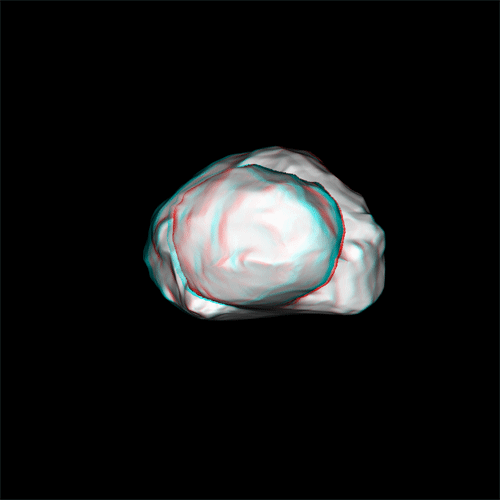
Use red-green/blue '3D' glasses to enjoy this version of the latest shape model.
Credits: ESA/Rosetta/MPS for OSIRIS Team MPS/UPD/LAM/IAA/SSO/INTA/UPM/DASP/IDA
Quelle: ESA
5825 Views
